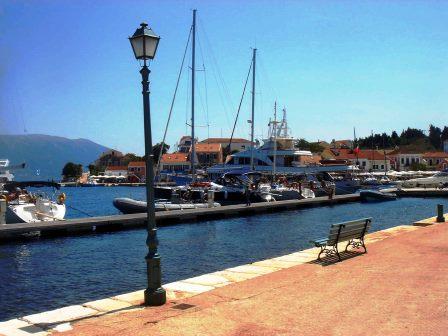The Area of Erissos covers the north part of the island. Wild beauty, spectacular sea, small forests of thick cypresses, scenery of unequalled physical feature suddenly seen between the cliffs and the balanced on the … chaos goats, villages untouched by the seismic catastrophes, all of them combine the character of this area. You will admire Assos peninsula crowned by the Venetian Castle and with the picturesque settlement down the hill. In addition, all the villages in Erissos have their beauty due to the fact that they did not destroyed by the earthquakes and thus they remain pure samples of the local architectural rhythm. It is more than certain that at the end of the main road the view will recompense you, because … here we are in Fiscardo! And if for your returning you choose the “back” road, you will be able to see fascinating gulfs and Ithaca so … small as you will be in an airplane. Have a look at the islet in the narrow marine passage: it is called Dascalio and is believed as the Homeric Asteris.
ASSOS: Small peninsula of unparalleled beauty with a extraordinary littoral settlement hidden among plane and poplar-trees. On the peninsula there are Venetian walls of about 2 km. built in the end of the 16th c. in order to defend the inhabitants from the incursions of different races pirates. If you dare to ascend at the strong fortress, you have to be sure that you will be recompensed. The fortress was inhabited until 1968. Today there are only ruins from the old Venetian buildings, a small church and the newly-built (1930) prisons which were abandoned in 1953 and are now renovated. The sunset as seen from the west side of the fortress is magnificent and unforgettable.
The amphitheatrical settlement on the tip of the peninsula,its idyllic, sheltered port with the fishing-boats and the yachts, the old mansions and the new houses with the oleanders, the jasmines and the boccamvillias, form a special, authentic atmosphere of the past. It is believed that the name Assos derives from the homonymous area in Asia Minor. Near the small square in the village stands the old olive-tree on which Saint Kosmas the Aetolian leaned as he taught.
FISCARDO: The traditional settlement with its cosmopolitan character is a well-known attraction of Erissos and offers a perfect idyllic sensation. Try wandering on the pebble-covered step–shaped narrow streets and along the coastal street. Don’t hesitate to take photos from the traditional 18th c. houses with their tiny balconies and their fantastic yards. During the summer the small port serves abundant yachts and luxury crafts. On Fournias or Htournias peninsula, opposite the village, you can admire the ruins of an early-Christian basilica from the 6th c. which stand possibly on an ancient temple. In 1438 Ioannis Palaeologos stayed there on his way to Florence. Near the ruins of the basilica there are two lighthouses, one of which dates to the Venetian period. This peninsula is the most ancient settlement in the Ionian Islands and the stone pre-historic finds and tools (dated back to 50.000 b.C.) from the Paleolithic Era are exhibited in the Archeological Museum in Argostoli. In Fiscardo an old Roman necropolis came to light and four stone sarcophagi with representations of Artemis were excavated. Also, stone baths named after the locals as “The Trone of the Queen Fiscarda” are found in a curved cavity of 2,3 m. width and 2,4 m. depth near Psilithrias in a territory called Spiliovouno.
The whole area was called Panormos and the Panormios Phoebus Apollo, patron of the sheltered ports, was worshipped. The new name “Fiscardo” derives from the Norman leader Robert Guiscard who died there in 1085 when Kefallonia was the homonymous Nautical Byzantine Thema. Don’t miss the church Our Lady the Platytera, the house of the famous Greek poet of the sea Nikos Kavadias and the old primary school where an educational-environmental exhibition is housed. From this cosy village you can walk until Maggano, or Emplysi.
MONASTERY OF PALIOHERSOU: Between Defaranata and Vary there is the Monastery of Paliohersou, a very old monastery devoted to Our Lady and built in 15th c.
VARY – PANAGIA KOUGIANA: You can visit the Post-Byzantine church with the cross-shaped roof and the wall-paintings which bring into mind scenes from the “Divine Comedy” of Dante.
ANTYPATA: Do admire the unique Russian rhythm church of the Resurrection, built in 1933 from a wealthy Kefallonian living in Russia.
PHOKI: Small beach after Fiscardo with many olive-trees reaching the wave.
EMPLYSI: Pebble beach with crystal clear blue-green water, of about a km. before Fiscardo.
ALATIES – AGIA ROUSSALI: In Tzamarelata village the north road leads to a rocky white beach called Alaties. If you follow the road to Halikeri you will reach the pebble beach of Agia Roussali. The local tradition says that once upon a time a pirate lost his son in a fight with the villagers and decided to bury him on the seashore where he built the church of Jerusalem. Now there are only the ruins of the church near the sea.
AGIA SOPHIA: From Komitata the road leads to the picturesque beach of Agia Sophia where there are some small houses near the sea, few fishing-boats and a lot of … loneliness. On your going down to the beach you will meet another beach named Gorgota, where there is still the diving-board from a scene of the film “Corelli’s mandolin”.
HAGIANA: From the village of Neohori the road ends to the beach of Hagiana. You must be careful because the street is narrow and twisted –as the majority of the roads in this area-.
Evridiki Livada

